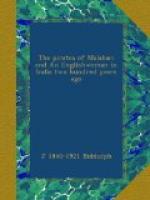In 1734, the Coolee rovers, who infested the coast of Guzerat, gave much trouble. Their stronghold was at Sultanpore, on the river Coorla, and they enjoyed the protection of several wealthy persons who shared in their plunder. A squadron under Captain Radford Nunn was sent against them, which captured five armed vessels and burnt fourteen more. To save others from capture they burnt about fifty more small sailing-boats themselves. Six months later, ten more of their boats were burnt and two captured. Under these blows they were quiet for a time.
In December, 1735, a valuable ship fell into Sumbhajee Angria’s hands, owing to the bad behaviour of its captain. The Derby, East Indiaman, bringing a great cargo of naval stores from England, and the usual treasure for investment, was due to arrive in Bombay in November. The captain, Anselme, was a schemer, and wished to remain in India for a year, instead of returning to England at once, as had been arranged. Accordingly, he lingered a month in Johanna, and shaped his course northward along the African coast. Thence getting a fair wind which would have brought him directly to Bombay, without running the risk of working along the Malabar coast, he, instead, steered for the latitude of Goa, and thence crept northwards, making as much delay as possible, so as not to reach Bombay till January. On the 26th December, an Angrian squadron of five grabs and four gallivats bore down on the Derby, off Severndroog, and engaged in their favourite way of attacking a big ship, astern. There was little wind, and the Derby would neither stay nor wear. Only two guns could be brought to bear at first; there were no guns mounted in the gun-room, and no encouragement was given to the crew. Two years before, the Directors had authorized the captains of outward-bound ships, when exposed to a serious attack, to hoist two treasure chests on deck, for distribution, after the engagement, to the ship’s company, in order to encourage them in making a good resistance. The captains of homeward-bound ships were empowered to promise L2000 to their crews in the same circumstances. Nothing of the kind was done by Anselme. The crew, discontented, fought with little spirit; many of them refused to stand to their guns. The main and mizzen masts were shot away, seven men, including the first mate, were killed, five were dangerously, and a number more slightly, wounded. Still, many of the officers and men were willing to continue the fight, but were overruled by the captain, who insisted on surrender, and the Derby with 115 prisoners, of whom two were ladies, was carried into Severndroog.
No such loss had befallen the Company for many years. The much-needed naval stores went to equip Angria’s fleet, and the money for the season’s investment was lost. The whole Bombay trade was dislocated. Angria, desirous of peace, opened negotiations. The Council, wishing to redeem the prisoners, offered a six months’ truce, and, after eleven months of captivity the prisoners were sent to Bombay, with the exception of three who took service with Angria.




